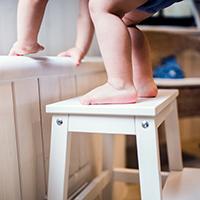A Lesson on Child-Proofing for Medicine Safety

Any parent will tell you that those early days of child-rearing can feel like a wild journey: You do everything you can to prepare yourself, but invariably, there are surprises. A lot of them! And that’s particularly true when it comes to your child’s development.
On paper, the developmental stages appear so straight-forward. Real life, by contrast, can look different: Kids often grow and develop according to their own schedule and, for better or worse, it’s not always perfectly aligned with a specific timetable. For a lot of parents, the uncertainty – when will my child do what – can be unsettling and challenging.
My 2-year old niece, Wren, is a perfect example of a child growing and changing at an unpredictable pace. For the most part, Wren’s mischief has been harmless, albeit messy (gallon of chocolate milk into the salad spinner kind of messy). But on a couple of occasions, she’s given my brother and sister-in-law quite a scare.
There was the time my sister-in-law, Laura, stepped out of the room for two minutes returning to find Wren eating her prenatal vitamins. Laura had no idea that Wren could access vitamins she’d left on her bedroom dresser. But it turns out, Wren was able to: (1) lift a heavy footstool; (2) move it in front of the dresser; and (3) reach up and get into vitamins that were in a child-resistant container!
Fortunately, Wren has no taste for prenatal vitamins; she spat them out. It was, however, a real eye-opener for my brother and sister-in-law. They had child-proofed most areas in their home, but they hadn’t focused on medicine safety. Like many parents, they assumed that they were already keeping medicine out of reach.
Incidents like these are not uncommon: In our latest research report, Safe Kids Worldwide found that, while parents know to keep medicine out of reach of children, there are still 52,000 kids each year going to the emergency room because they got into medicine. That’s one child every ten minutes. The good news is that there are simple steps you can take to keep your child safe around medicine.
QUICK TIPS TO HELP PARENTS
- Keep medicine and vitamins out of children’s reach and sight, even medicine you take every day. Think about places you store medicine you don’t use regularly, as well as places you keep medicine that you use more frequently. Children often find medicine kept in purses or on counters and nightstands, so it is important to put medicine in cabinets at or above counter height, even if you need to take another dose in a few hours. Keep all bags or briefcases on high shelves or hang them on hooks where your child can’t reach them.
- Add medicine safety to your initial child-proofing checklist. As you create a safer home environment for your child to grow and explore, it’s important to add medicine safety to your list along with installing safety gates and cabinet locks, anchoring furniture, mounting TVs, and putting poisonous products up and away. As your child learns new skills and becomes more mobile, anticipate that you may need to change where you keep medicine to avoid alarming surprises.
- Save the Poison Help number in your phone and post it visibly at home: 1-800-222-1222. Specialists at poison control centers provide free, confidential, expert medical advice 24 hours a day. They can answer questions about how to give or take medicine and help with poison emergencies.
- Share medicine safety information with family and friends. Teach other caregivers such as family members, babysitters and friends about medicine safety and make sure they know the Poison Help number.
More tips for families can be found in the medicine safety checklist and medicine safety tip card.
